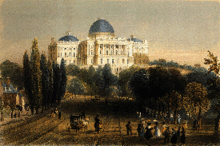Twenty-second Congress
| 22nd United States Congress | |
|---|---|
|
21st ←
→ 23rd
|
|

United States Capitol (1827)
|
|
| March 4, 1831 – March 4, 1833 | |
| Senate President |
John C. Calhoun (J) until December 28, 1832 Vacant from December 28, 1832 |
| Senate Pres. pro tem: |
Samuel Smith (J) Littleton Tazewell (J) Hugh L. White (J) |
| House Speaker: | Andrew Stevenson (J) |
| Members: | 48 Senators 213 Representatives 3 Non-voting members |
| Senate Majority: | Jacksonian |
| House Majority: | Jacksonian |
| Sessions | |
|
1st: December 5, 1831 – July 16, 1832 2nd: December 3, 1832 – March 2, 1833 |
|
The Twenty-second United States Congress was a meeting of the legislative branch of the United States federal government, consisting of the United States Senate and the United States House of Representatives. It met in Washington, D.C. from March 4, 1831 to March 4, 1833, during the third and fourth years of Andrew Jackson's presidency. The apportionment of seats in the House of Representatives was based on the Fourth Census of the United States in 1820. Both chambers had a Jacksonian majority.
The count below identifies party affiliations at the beginning of the first session of this congress. Changes resulting from subsequent replacements are shown below in the "Changes in membership" section.
This list is arranged by chamber, then by state. Senators are listed in order of seniority, and Representatives are listed by district.
Senators were elected by the state legislatures every two years, with one-third beginning new six-year terms with each Congress. Preceding the names in the list below are Senate class numbers, which indicate the cycle of their election. In this Congress, Class 1 meant their term ended with this Congress, requiring re-election in 1832; Class 2 meant their term began in the last Congress, requiring re-election in 1834; and Class 3 meant their term began in this Congress, requiring re-election in 1836.
The names of members of the House of Representatives are preceded by their district numbers.
All representatives were elected statewide on a general ticket.
All representatives were elected statewide on a general ticket.
The 5th district was a plural district with two representatives.
All representatives were elected statewide on a general ticket.
All representatives were elected statewide on a general ticket.
...
Wikipedia
